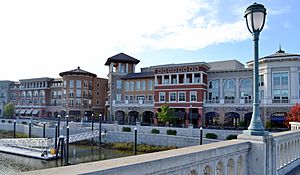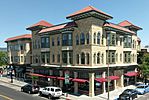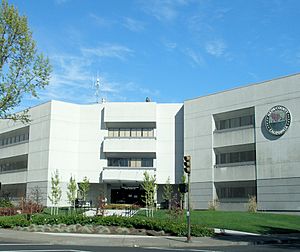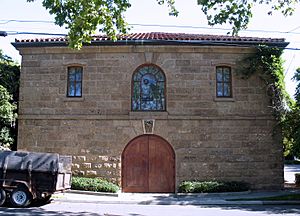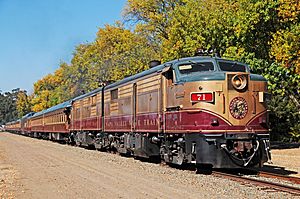Napa, California facts for kids
Quick facts for kids
Napa, California
|
|
|---|---|
|
Clockwise: Napa Waterfront; Alexandria Hotel; Darioush Winery; Downtown Napa; Domaine Carneros
|
|
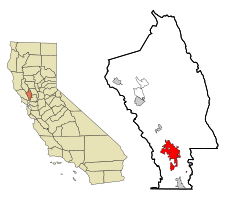
Location in Napa County and the state of California
|
|
| Country | United States |
| State | California |
| County | Napa |
| Region | Northern California |
| Incorporated | March 23, 1872 |
| Government | |
| • Type | Mayor and Council Government |
| Area | |
| • City | 18.28 sq mi (47.33 km2) |
| • Land | 17.97 sq mi (46.54 km2) |
| • Water | 0.31 sq mi (0.79 km2) 1.69% |
| Elevation | 20 ft (6 m) |
| Population
(2020)
|
|
| • City | 79,246 |
| • Estimate
(2022)
|
77,480 |
| • Density | 4,348.1/sq mi (1,678.80/km2) |
| • Metro | 138,019 |
| Time zone | UTC-8 (Pacific (PST)) |
| • Summer (DST) | UTC-7 (PDT) |
| ZIP Codes |
94558, 94559, 94581
|
| Area code | 707 |
| FIPS code | 06-50258 |
| GNIS feature IDs | 277561, 2411209 |
Napa is the biggest city and the main government center of Napa County. It's a major part of the famous Wine Country in Northern California, United States. Located in the North Bay area of the Bay Area, Napa had about 77,480 people living there at the end of 2021. Napa is a popular place for tourists in California, known for its many wineries, great restaurants, and lively arts scene.
Contents
History of Napa
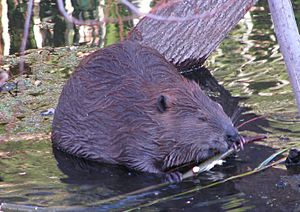
Early Days of Napa
The name "Napa" likely comes from a local Native American village. For many centuries, native people shared this area with animals like elk, deer, grizzlies, and cougars. The first recorded trip into Napa Valley was in 1823. At that time, most people living there were Native American Indians.
Spanish priests tried to convert some natives. Later, American farmers started to arrive in the 1830s. In 1850, Napa became one of California's first counties. Sadly, tensions grew between white settlers and Native Americans. This led to conflict, and many native people were forced to move north.
Founding the City
The City of Napa was started by Nathan Coombs in 1847. The first business was a saloon, and the first general store opened a year later. Ships began using the Napa River for trade, helping the town grow. By 1850, steamboats were bringing passengers and goods.
In the mid-1850s, Napa's Main Street was very busy. John Patchett opened the first commercial winery in the county in 1859. This winery was located right where Napa city is today. Many important people who helped build Napa, like Nathan Coombs, are buried in Tulocay Cemetery. Also buried there is Mary (Mammy) Pleasant, who is known as the Mother of Civil Rights in California.
Gold Rush and New Workers
The California Gold Rush in the late 1850s helped Napa grow. When winter hit the gold fields hard, many miners came to Napa to escape the cold and floods. They found plenty of work in the valley, especially in cattle ranching and the lumber industry.
Later, in the 1860s, a "silver rush" began in Napa Valley. Quicksilver mines opened in many areas. The Silverado Mine was even written about by Robert Louis Stevenson in his book The Silverado Squatters.
To help with all the work, people from other countries came to Napa. In the 1860s, Chinese laborers arrived to help build roads and work in mines. Later, in the 1880s, many young men from Italy came to work in the mines and on farms. These new groups helped Napa grow and become more diverse.
Napa's Growth and Inventions
A settlement for Chinese workers was set up in Napa in the early 1860s. By the 1880s, over 300 Chinese people lived there. In 1869, the Sawyer Tanning Company started in Napa. It became the biggest tannery west of the Mississippi River. The famous Nappa leather was actually invented in Napa in 1875 by Emanuel Manasse, who worked at this company!
Napa officially became a city on March 23, 1872. Louis Bruck was elected as the first mayor. The Napa State Hospital opened in 1876, and the Napa Valley Opera House became popular after it opened in 1880.
In 1915, Edwin Pridham and Peter L. Jensen invented the moving-coil loudspeaker in their workshop in Napa. This amazing invention led them to start the Magnavox Company in 1917.
Modern Napa
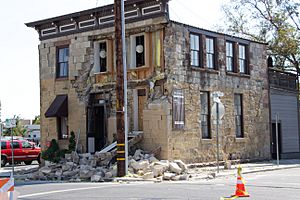
By the early 1900s, Napa was the main business center for the Napa Valley. A railway was built in 1905, carrying people and goods from Vallejo to Napa and other towns.
Flooding from the Napa River has been a problem for the city for a long time. There have been many big floods since 1862. After a major flood in 1986, people decided to do something about it. They started the Napa River Flood Project in 1998. This project aims to control flooding and help the river's environment. Thanks to this project, animals like beavers have returned to the river.
In the 2000s, downtown Napa started to become popular again. Many new restaurants and hotels opened, especially along the Napa riverfront. On August 24, 2014, a magnitude 6.0 earthquake hit the Napa area, causing some damage.
Geography of Napa
Napa covers about 18.1 square miles (47 square kilometers). Most of this is land, with a small part being water. Napa was the first place in California to be part of the North Coast American Viticultural Area, which means it's recognized for its wine. Even though it's famous for wine, only about 9% of Napa's land is used for growing grapes.
The Napa River flows through the city on its way to the San Pablo Bay. The city has been working to improve the riverfront. The Napa River Flood Project is a big effort to reduce flooding along 6 miles (9.7 km) of the river and 1 mile (1.6 km) of Napa Creek.
Napa's Climate
Napa has a Mediterranean climate, which means it has cool, wet winters and warm, dry summers. Rain is rare during the summer months. Sometimes, it can get very hot, with temperatures going above 100°F (38°C). Wildfires can be a concern in the summer.
Fall is a lovely time to visit Napa. Winters are quite wet and cool, and flooding can be an issue. Temperatures at night can sometimes drop below freezing (32°F or 0°C). Snow is very rare. The most rainfall in one year was 51.24 inches (130.1 cm) in 1983. The hottest temperature ever recorded in Napa was 114°F (46°C) on September 6, 2022.
| Climate data for Napa, California (Napa County Airport), 1991–2020 normals, extremes 1893–present | |||||||||||||
|---|---|---|---|---|---|---|---|---|---|---|---|---|---|
| Month | Jan | Feb | Mar | Apr | May | Jun | Jul | Aug | Sep | Oct | Nov | Dec | Year |
| Record high °F (°C) | 85 (29) |
86 (30) |
92 (33) |
95 (35) |
104 (40) |
113 (45) |
110 (43) |
110 (43) |
114 (46) |
106 (41) |
90 (32) |
81 (27) |
114 (46) |
| Mean maximum °F (°C) | 67.1 (19.5) |
73.4 (23.0) |
79.0 (26.1) |
86.7 (30.4) |
91.6 (33.1) |
98.3 (36.8) |
98.2 (36.8) |
98.1 (36.7) |
98.2 (36.8) |
91.4 (33.0) |
78.2 (25.7) |
66.9 (19.4) |
102.5 (39.2) |
| Mean daily maximum °F (°C) | 56.9 (13.8) |
60.9 (16.1) |
64.2 (17.9) |
68.1 (20.1) |
73.1 (22.8) |
78.3 (25.7) |
78.7 (25.9) |
80.0 (26.7) |
80.3 (26.8) |
75.4 (24.1) |
65.1 (18.4) |
57.3 (14.1) |
69.9 (21.0) |
| Daily mean °F (°C) | 47.6 (8.7) |
50.4 (10.2) |
53.0 (11.7) |
55.8 (13.2) |
60.5 (15.8) |
65.1 (18.4) |
66.7 (19.3) |
67.2 (19.6) |
65.7 (18.7) |
60.6 (15.9) |
52.7 (11.5) |
47.5 (8.6) |
57.7 (14.3) |
| Mean daily minimum °F (°C) | 38.2 (3.4) |
40.0 (4.4) |
41.7 (5.4) |
43.5 (6.4) |
47.8 (8.8) |
51.8 (11.0) |
54.8 (12.7) |
54.4 (12.4) |
51.0 (10.6) |
45.9 (7.7) |
40.4 (4.7) |
37.6 (3.1) |
45.6 (7.6) |
| Mean minimum °F (°C) | 29.5 (−1.4) |
32.4 (0.2) |
34.3 (1.3) |
36.8 (2.7) |
41.9 (5.5) |
46.5 (8.1) |
50.3 (10.2) |
49.8 (9.9) |
46.1 (7.8) |
40.3 (4.6) |
33.3 (0.7) |
29.1 (−1.6) |
27.4 (−2.6) |
| Record low °F (°C) | 19 (−7) |
23 (−5) |
23 (−5) |
27 (−3) |
30 (−1) |
34 (1) |
38 (3) |
37 (3) |
36 (2) |
28 (−2) |
25 (−4) |
14 (−10) |
14 (−10) |
| Average precipitation inches (mm) | 5.12 (130) |
5.53 (140) |
3.91 (99) |
1.89 (48) |
1.02 (26) |
0.22 (5.6) |
0.01 (0.25) |
0.02 (0.51) |
0.27 (6.9) |
1.55 (39) |
3.49 (89) |
5.23 (133) |
28.26 (718) |
| Average precipitation days (≥ 0.01 in) | 9.9 | 9.8 | 9.6 | 5.9 | 3.2 | 1.0 | 0.1 | 0.2 | 1.0 | 3.2 | 7.2 | 10.3 | 61.4 |
| Source 1: NOAA | |||||||||||||
| Source 2: National Weather Service | |||||||||||||
People of Napa
| Historical population | |||
|---|---|---|---|
| Census | Pop. | %± | |
| 1850 | 159 | — | |
| 1870 | 1,879 | — | |
| 1880 | 3,731 | 98.6% | |
| 1890 | 4,395 | 17.8% | |
| 1900 | 4,036 | −8.2% | |
| 1910 | 5,791 | 43.5% | |
| 1920 | 6,757 | 16.7% | |
| 1930 | 6,437 | −4.7% | |
| 1940 | 7,740 | 20.2% | |
| 1950 | 13,579 | 75.4% | |
| 1960 | 22,170 | 63.3% | |
| 1970 | 36,103 | 62.8% | |
| 1980 | 50,879 | 40.9% | |
| 1990 | 61,842 | 21.5% | |
| 2000 | 72,585 | 17.4% | |
| 2010 | 76,915 | 6.0% | |
| 2020 | 79,246 | 3.0% | |
| 2023 (est.) | 76,821 | −0.1% | |
| U.S. Decennial Census | |||
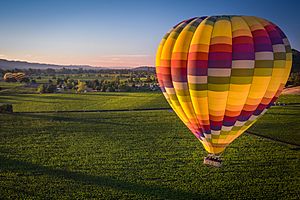
In 2010, Napa had a population of 76,915 people. This means there were about 4,238 people living in each square mile. Most of the people (75.1%) were White. About 17.2% were from other races, and 3.7% were from two or more races. A large group, 37.6%, identified as Hispanic or Latino.
Most people in Napa live in homes, not in group housing. There were 28,166 households. About 34.9% of these households had children under 18. The average household had about 2.69 people.
The population included people of all ages. About 24.5% were under 18, and 13.6% were 65 or older. The average age in Napa was 37.4 years.
Napa's Economy
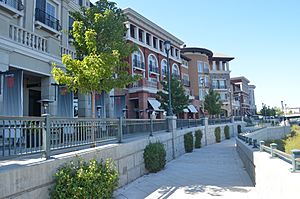
Napa's economy is strongly linked to its role as a main city in Wine Country. This means many jobs in Napa are in wineries, restaurants, hotels, and other tourism-related businesses.
The Napa State Hospital is located just outside Napa. The Napa Valley Business Park is also nearby, close to the Napa County Airport. Companies like The Doctors Company and Treasury Wine Estates have offices there.
Top Employers in Napa

Here are the top ten employers in the City of Napa, based on a report from June 30, 2020:
| No. | Top Employers | Employees |
|---|---|---|
| 1 | Napa Valley Unified School District | 1,735 |
| 2 | County of Napa | 1,209 |
| 3 | City of Napa | 434 |
| 4 | Walmart | 300 |
| 5 | Napa Valley College | 290 |
| 6 | Kaiser Permanente | 262 |
| 7 | The Meadows of Napa Valley Assisted Living | 193 |
| 8 | Napa Valley Wine Train | 193 |
| 9 | The Westin Verasa Napa | 168 |
| 10 | Napa Valley Marriott Hotel & Spa | 164 |
Getting Around Napa
Main roads like CA-29 and CA-12 run through or near Napa. These roads connect the city to other places like Vallejo, Fairfield, and the Napa Wine Country.
For air travel, there are several airports nearby. Oakland and San Francisco International are about 50 miles (80 km) south. Sacramento International Airport is about 65 miles (105 km) northeast. The small Napa County Airport is also available for public use.
Napa has a public transportation system called Valley Intercity Neighborhood Express, or VINE Transit. It offers bus services throughout Napa County and connects to other public transport systems in nearby areas.
The Amtrak Thruway 7 bus also stops daily in Napa. From this stop, you can connect to train services in Martinez or bus services going north to Arcata.
Famous People from Napa
- Larry Allen, former NFL player
- Max Alvarez, soccer player
- Alisa Bellettini, TV producer
- Jerry Bohlander, mixed martial arts fighter
- John Boyett, former NFL player
- Warren Brusstar, MLB player
- Bill Buckner, MLB player
- Cristina García, novelist
- Mike Gibson, NFL player
- Bill Green, Olympic athlete
- Steve Hendrickson, former NFL player
- Adam Housley, news correspondent
- Josh Jackson, NBA player
- Joe Kmak, MLB player
- Jim Landis, MLB player
- Ray Manzarek, The Doors keyboard player
- Scott McCarron, Professional Golfer
- Peter Menzel, photographer
- Johnny Miller, golfer
- Olivia O'Brien, musician
- Donny Robinson, Olympic BMX medalist
- Andrew Talansky, Professional Cyclist
- Shirley Walker, film composer
- Charles Woodson, former NFL player and Heisman Trophy winner
Sister Cities
Napa has special connections with cities in other countries, called sister cities:
 Casablanca, Chile
Casablanca, Chile Iwanuma, Japan (since 1973)
Iwanuma, Japan (since 1973) Launceston, Australia
Launceston, Australia
Images for kids
See also
 In Spanish: Napa para niños
In Spanish: Napa para niños


